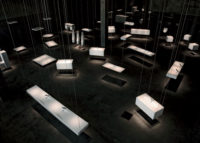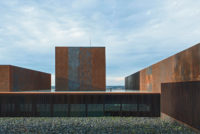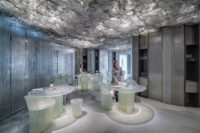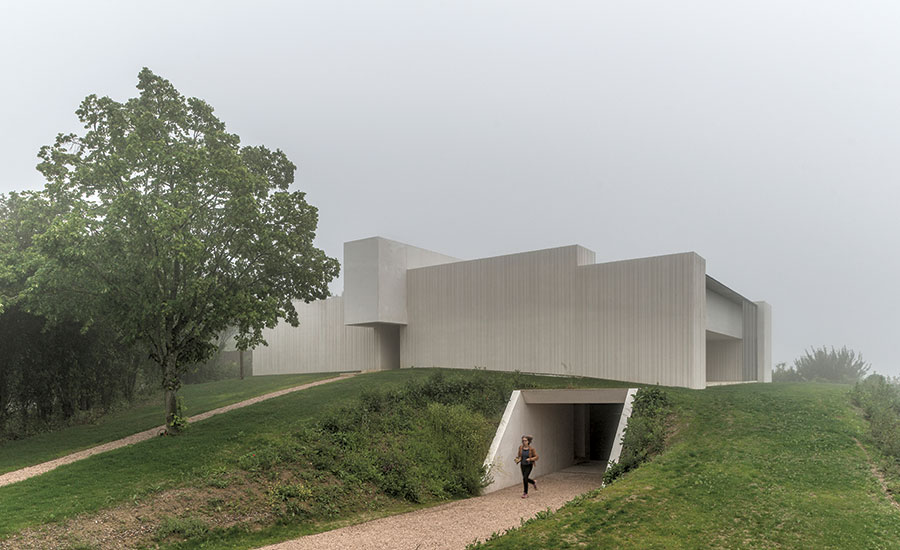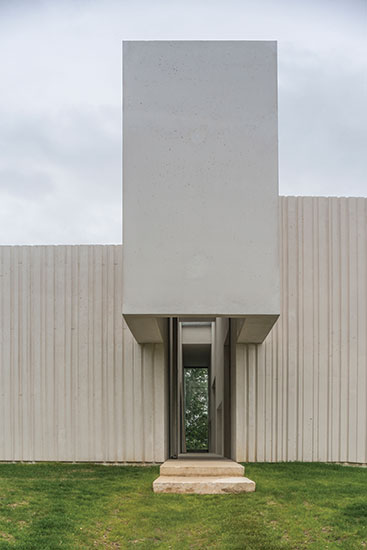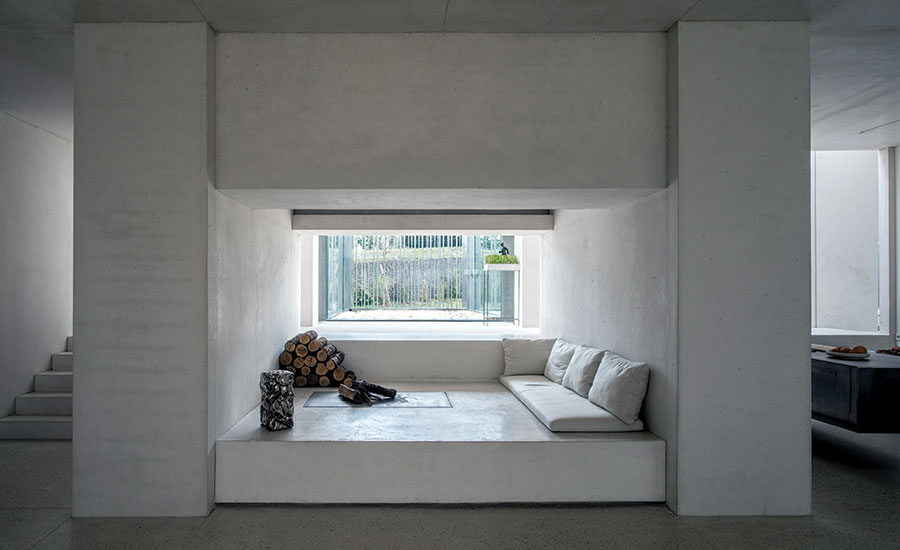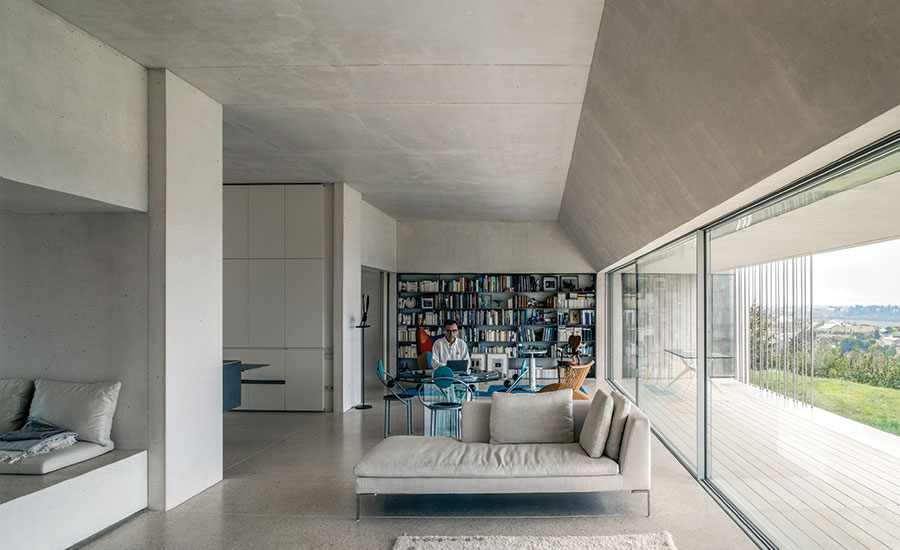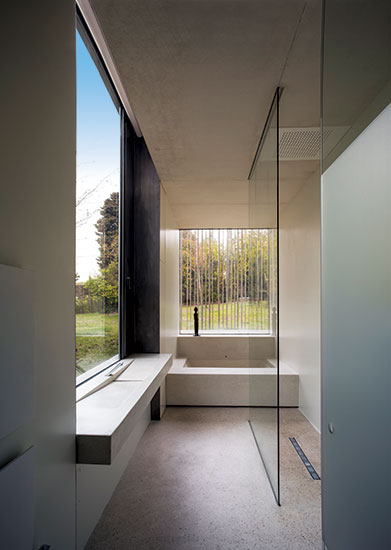Maison Malecaze by RCR Arquitectes
Toulouse, France

The house’s main level, above the garage, conforms to the rolling hills it sits upon.
Photo © Pep Sau

The main entrance is beneath a large hood.
Photo © Pep Sau

The concrete striations give way to loosely spaced vertical metal rods over existing walls and windows.
Photo © Pep Sau

One of the two courtyards is planted with a cherry tree.
Photo © Pep Sau

A fireplace defines a small nook off the large living area.
Photo © Hisao Suzuki

Views from that main living space are compressed by the swimming pool’s underside above the terrace.
Photo © Hisao Suzuki

Concrete is variously utilized within the house to form washbasins in the master bath, to embed the cantilevering counters in the kitchen, and to alternate the treads of the steps that separate the master suite from the spinal corridor.
Photo © Hisao Suzuki

Concrete is variously utilized within the house to form washbasins in the master bath, to embed the cantilevering counters in the kitchen, and to alternate the treads of the steps that separate the master suite from the spinal corridor.
Photo © Hisao Suzuki

Concrete is variously utilized within the house to form washbasins in the master bath, to embed the cantilevering counters in the kitchen, and to alternate the treads of the steps that separate the master suite from the spinal corridor.
Photo © Pep Sau

A canyon-like staircase leads to the rooftop pool and its views over the valley of the Garonne River.
Photo © Pep Sau

A canyon-like staircase leads to the rooftop pool and its views over the valley of the Garonne River.
Photo © Hisao Suzuki

Image courtesy RCR Arquitectes

Drawing courtesy RCR Arquitectes

Image courtesy RCR Arquitectes














Architects & Firms
It was, as is not infrequent in these cases, all about the view. For if Professor Malecaze had acquired a modest property in this sparsely built suburb of Toulouse, it was precisely because of the stunning panorama it offered across the valley of the Garonne River toward the Pyrenees on the far horizon. But he wasn’t so keen on the small 1970s house that came with the lot, which he found not only too poky for his needs but also too closed with respect to the natural splendors the site enjoyed. And his chosen architects—discovered by chance on a trip to Spain, long before their 2017 Pritzker Prize win—agreed. “The view across the valley is so powerful that we wanted to do a house based around it,” says Carme Pigem, the C in Catalonia-based RCR Arquitectes.
Additional Content:
Jump to credits & specifications
Malecaze’s requirements were clear: besides championing that view, he wanted a house big enough to accommodate his three grown children when they came to stay; he wanted everything on one level, since he and his wife weren’t getting any younger; and, given the warm summers in the region, he wanted a pool. Which left RCR with a conundrum, since the local planning regulations made combining all of that rather complicated. What Malecaze was essentially asking for was a new house, but demolition of the old one was prohibited: to prevent overdevelopment on these rolling green hills, the regulations specified that, once a building was torn down, its site became inconstructible and could never be built upon again. Moreover, the percentage of the plot that could be covered by any extension was restricted, which meant— given that Malecaze wanted everything on the same level—there would be no room for a pool. Then there was the site’s steep slope, and the fact that major embankment work was not allowed. It was from these constraints—essential grist to the artist’s mill—that RCR’s Maison Malecaze was born.
Rules are there if not to be broken, at least to be bent, and in the end just two walls of the old house were retained (altered beyond recognition, no less). The client’s wishes were also bent in the interests of practicalities and spatial poetics, so, rather than being on exactly the same level, the “extension” is about 3 feet lower, reducing embankment work and allowing a Raumplan. As for the swimming pool, the only place left to put it was on the roof. “But it’s good when the constraints are on your side,” says Pigem wryly, “since we wanted to leave the site as untouched as possible.” The rooftop pool determined the structure: two massive concrete bookends—one containing the dressing room and laundry, the other the stairways down to the basement garage and up to the rooftop—that carry the beams supporting the pool. The bookends also flank the fluid new living spaces—but this is rather jumping the gun.
Arriving at the house, you are confronted by a blind fortress of a facade, in pale striated concrete, with an equally pale path leading up to the low hood of the entrance canopy. (In other parts of the facade—over the existing exterior walls and new glazed areas—the striations take the form of vertical metal rods.) Once inside the hood’s somber gloom, you’re suddenly faced with an enormously tall steel door, the first in a series of compressions and dilations that modulate your experience as you move around the house. The door opens into an equally tall entrance corridor, lit from above, off which one can access the three guest bedrooms to the left (located within the perimeter of the old house), the parents’ quarters at the end, and the main living area down steps to the right. Taking the latter, you arrive in a long, airy, spacious volume where you are immediately met by another violent compression, since the swimming pool (although one doesn’t realize that yet) dramatically narrows the band of glazing running along the entire facade, clenching one’s first experience of the famous view into a frame even more stretched and panoramic than Cinemascope. (The pool’s width also creates a protected terrace, sufficiently deep to prevent rain’s reaching the fenestration.)
More dramatic compression is just behind us, in the form of a modernist inglenook at one end and the master-bedroom alcove at the other, while between them is another dilation—the kitchen. All three open onto the spinal corridor, thus forming “a single but highly differentiated space, allowing both a unitary vision and rich spatial variety,” as Pigem explains. Furthermore, RCR set itself the added constraint of inscribing all the Maison Malecaze’s accommodation within one strict rectangle in a more or less symmetrical plan. “We wanted to integrate the old house into a new ensemble using measured proportions,” Pigem explains. Thus the new master bathroom completes the rectangle at the back, with two courtyards breaking up the perimeter, one planted with a cherry tree onto which looks a small office space (part of the master suite), while the other contains a pebble-filled reflecting pool surrounded by the fully glazed inner facades of the guest bedrooms.
As well as a bravura response to logistics, the Maison Malecaze is a dwelling of endless subtleties: you can look from the master bathroom washbasin through the rest of the house out to the famous view; two of the guest bedrooms can be combined as a gym thanks to a sliding wall; the kitchen table and drawers are realized in levitating cantilevered steel, as is the master bed (“We don’t like furniture legs,” says Pigem. “We want everything to appear light”); alternating tread steps separate as much as they join the parents’ quarters and the spinal corridor; and the house’s cream-colored concrete is used as a language, grammatically inflected in different ways—brut de décoffrage, bush-hammered rough, bush-hammered polished, molded to form baths, washbasins, and so on. “In our architecture, we avoid using lots of different materials,” clarifies Pigem. “We prefer to bring out the intrinsic richness of just one or two.”
The color of the concrete was the one point where Malecaze put his foot down (the architects wanted it dark gray), otherwise giving RCR entirely free rein to interpret his “unspoken wishes.” One such unexpressed desire is the dramatic stairway to the rooftop, where that view takes over again. While stopping short of the Villa dall’Ava’s Koolhaasian contrariness (Rem famously didn’t want it to be all about the rooftop-swimming-pool view of the Eiffel Tower), the route up top here is the final sequence of compression and dilation, as you move from a narrow dark canyon of a staircase to a platform in the sky, the spinal corridor now a parapet pushing you forward toward a thin ribbon of blue, a last deliquescent strip of sensuality between you, the Pyrenees, and infinity.
CreditsArchitect: RCR Arquitectes — Rafael Aranda, Carme Pigem, Ramon Vilalta, partners; A. Moura, I. García, A. Saez, S. Figueras, D. Breathnack, K. Fujii, project team
Consultant: Blázquez-Guanter (structure)
General contractor: Àrids Vilanna |
SpecificationsMetal and glass curtain wall Alumilux
Plumbing Lagares
Swimming pool Everblue |


